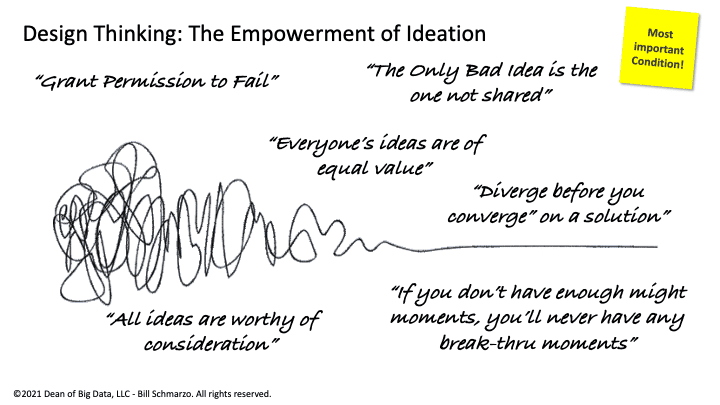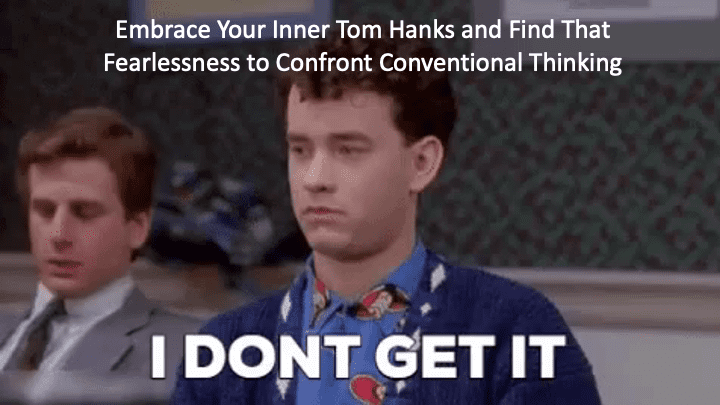
“Courage is not the absence of fear, but rather the judgment that something else is more important than fear. The brave may not live forever, but the cautious do not live at all”
– Philippe Renaldi, The Princess Diaries (2001)
Optimizing versus innovating…the simple difference between surviving versus thriving. Yes, it is always easier to apply advanced technologies such as Big Data, AI / ML, and Edge Analytics to optimize an existing process. But what if that process is out-of-date, or worse yet, wrong. Is your organization applying AI / ML to accelerate your organization’s race to irrelevance? Here is a damning example of what can go wrong when an organization focuses on optimizing an existing flawed process.
The article “Former USC Education-School Dean Pushed Flawed Rankings Data” highlights the dangers that organizations face in trying to apply advanced analytics to optimize against outdated and possible irrelevant processes. The ex-dean of USC’s education school directed administrators to omit data from its U.S. News & World Report rankings submission to boost the school’s college ranking that is used by many students to influence their college selection.

The U.S. News & World Report college rankings has taken on a life of its own in a ludicrous scramble to boil a prospective student’s college choice down to a single number. This is causing some universities to take an unhealthy focus on applying data and analytics to “game the system” instead of focusing on understanding where and how they can create real value for their students and their university ecosystem.
Universities that are trying to optimize on the singular U.S. News & World Report college rankings are just optimizing the cow path. That is, these universities are trying to optimize a metric that may have no relationship to where and how real “value” is created for the students, for the university, and for the university’s community.
Universities need to ask themselves some hard questions about this fanatical focus on the U.S. News & World Report college rankings:
- Are a university’s most promising prospects – ones that offer the most “value” to the university and the university community over their lifetime – ones that rely on a single number to guide their university decision?
- Is that really the type of student that you want – one can’t think beyond a single, artificial number to make that critical university decision?
Is your organization caught in the tyranny of optimizing against a metric that may not holistically reflect how your organization creates value? Does your industry gravitate to that single metric, but no one is willing to question the rationale behind that metric? And are you afraid to be the first to question that metric?
Then it’s time to strap them on and step up to the challenge. Time to get #Fearless!
The First Step Towards Re-invention: Fearlessness
There is an opportunity for universities to re-invent how they profile, target, and recruit their ideal prospects – prospects that offer the most value to the university and the university community. That means thoroughly understanding where and how the university creates “value” and how the university stakeholders (students, faculty, alumni, local community, etc.) measure that value creation effectiveness.
If you want to change the game, change the frame.
Being that first-mover who bucks conventional thinking and “the way that we have always done it” requires fearlessness. A great example of the combination of fearlessness and the game-changing potential of data and analytics is the “Moneyball” story.
In the early 2000s, the Oakland Athletics General Manager Billy Beane decided to leverage advanced baseball analytics (called sabermetrics) to build a baseball team that could both win games AND be financially frugal. Bill James pioneered the idea that by leveraging advanced baseball metrics, general managers could assemble a team of players who, contrary to traditional measures, would perform better than flashier, more expensive ballplayers. And the results were dramatic. If you want to measure the success of a sports organization, then wins per total player salary would be an important KPI).

Figure 1: Changing the Game Data Science Lessons from “Moneyball”
Yes, the advanced baseball analytics gave Billy Beane a quantifiable advantage when competing with more wealthy franchises to build winning baseball teams at bargain-basement prices. But to go full Cortez and actually burn the ships at the beach in using advanced analytics to drive baseball decisions, required fearlessness.
What does it mean for a leader and their organization to be fearless (Figure 2)?
- Willingness to fail and allow others to fail. But that doesn’t mean taking uninformed or stupid risks. Careful consideration needs to be given before taking action including capturing the costs of failure and exploring the potential unintended consequences of the decision.
- Willingness to run against the crowd, to color outside the lines. If you are seeking extraordinary results, then you can’t be doing what everyone else is doing. We must be willing to run face-first against conventional thinking. That might mean letting go of those conventions that have guided your decision-making in the past. But you can’t climb a ladder if you’re not willing to let go of the wrung below you.
- Determined but not arrogant. The leader and the team must be determined and committed to the journey but can’t be arrogant and not be willing to learn and adapt along with that transformational journey. Sometimes the path to the top isn’t a straight line.
- Experienced, not expert. Sorry, but anyone who claims to be an expert, is either lying or works in a world where nothing ever changes. But we can be experienced and seek to continuously learn and adapt to ensure that our experiences are relevant to the problem at hand.
- Fail fast, Learn faster. You can’t learn if you’re not willing to fail. And one certainly cannot re-invent if they aren’t willing to explore multiple ideas in hopes of finding those solutions that “might” work. Remember, if you don’t have enough “might” moments, then you’ll never have any breakthrough moments.

Figure 2: What Does it Mean to Be #Fearless
Fearlessness, Design Thinking, and Embracing Natural Anxiety from Re-invention
To transition from optimization to reinvention, you must create a culture that is willing to challenge conventional thinking by empathizing, exploring, trying, failing, learning, and trying again to find more effective ways to deliver desired outcomes. That’s the space of Design Thinking (Figure 3).

Figure 3: Design Thinking Is…
Design Thinking leverages group collaboration and brainstorming/envisioning techniques to discover unmet customer and market needs within the context and constraints of a particular customer journey. Design thinking accomplishes this by empowering everyone to challenge conventional thinking and freely explore new ideas – to be fearless (Figure 4).

Figure 4: Design Thinking: The Empowerment of Ideation
Design Thinking excels in creating fearlessness in an organization across two critical dimensions:
- Organizational Transformation. Design Thinking creates a team culture of inclusion and empowerment where all ideas are worthy of consideration, and everyone has an equal voice. I’m always surprised (is “always surprised” an oxymoron?) that the best ideas come from the folks who are closest to the customers and the operations of the business.
- Customer Transformation. Design Thinking forces an intimate organizational focus on understanding your customers’ intentions, objectives, and desired outcomes. Design Thinking can help to identify and quantify the sources of customer value realization and the impediments to that value creation by reframing the customer engagement towards the delivery of operational outcomes (versus just inundating them with a laundry list of features and functionality).
Organizational Fearlessness: Embrace Your Inner Tom Hanks
Everything that we need – the data science tools (via Data Science, Data Management, and AI / ML) and the organizational transformation techniques (via design thinking) – to fully exploit the potential of AI to reinvent business and operational processes and transform business models are readily available to everyone (Figure 5). No excuses.

Figure 5: Design Thinking Synergizes with Data Science to Unleash the Potential of AI
Now, all that is needed to unleash the potential of AI is to create a culture of fearlessness…is you!
You must be willing to step up and speak out. You must be willing to fly in the face of conventional thinking. You must be willing to stand alone. You must be willing to embrace your inner Tom Hanks (Josh from the movie “Big”) with a willingness to state “I don’t get it” if we as a society are to unleash the full potential of AI…and humans!

Figure 6: Tom Hanks in the movie “Big” (1988)
Going back to our university example, it’ll be interesting to see if any fearless universities will be willing to challenge the frame of today’s student recruitment game. Much value and glory can come to that first mover, but it’s very scary to be the first mover when the organizational and market inertia is working against you.
Be fearless, baby!
